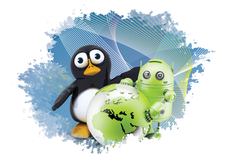Running Windows apps on Linux with PlayOnLinux
Playing Nice

Getting Windows programs to work on Linux is difficult even if you're using the famous Wine Windows-compatibility environment. Fortunately, the PlayOnLinux graphical interface can ease some of the pain.
Linux developers have made great strides in their efforts to accommodate users from Windows environments. You now can play most video and audio formats, even Windows-specific formats, directly on Linux media players. Distribution maintainers package proprietary video card drivers, so a game that requires support for 3D hardware-accelerated hardware is only a couple of clicks away; and, even MS Office files are easy to open, edit, and save thanks to LibreOffice, OpenOffice, and Calligra.
Sometimes opening and importing files created in Windows is not enough, however. What if you want – or need – the exact same program you used in Windows. (Many hardcore Linux users would question whether you really need a Windows application, but let's assume you really do need to run it just one last time.)
PlayOnLinux [1] helps you run your Windows programs in Linux. Although PlayOnLinux might look like a simple graphical front end for the venerable Wine [2] compatibility layer – the classic solution for running Windows on Linux – but PlayOnLinux is actually a bit more. With Wine, you download the application you need to run, guess the configuration that will work, hit Enter, and cross your fingers. Granted, if something goes wrong, the Wine project has a comprehensive database of solutions, and the community is really helpful, but PlayOnLinux has the advantage of removing a lot of the guess work.
[...]
Buy this article as PDF
(incl. VAT)
Buy Linux Magazine
Subscribe to our Linux Newsletters
Find Linux and Open Source Jobs
Subscribe to our ADMIN Newsletters
Support Our Work
Linux Magazine content is made possible with support from readers like you. Please consider contributing when you’ve found an article to be beneficial.

News
-
Zorin OS 18 Hits over a Million Downloads
If you doubt Linux isn't gaining popularity, you only have to look at Zorin OS's download numbers.
-
TUXEDO Computers Scraps Snapdragon X1E-Based Laptop
Due to issues with a Snapdragon CPU, TUXEDO Computers has cancelled its plans to release a laptop based on this elite hardware.
-
Debian Unleashes Debian Libre Live
Debian Libre Live keeps your machine free of proprietary software.
-
Valve Announces Pending Release of Steam Machine
Shout it to the heavens: Steam Machine, powered by Linux, is set to arrive in 2026.
-
Happy Birthday, ADMIN Magazine!
ADMIN is celebrating its 15th anniversary with issue #90.
-
Another Linux Malware Discovered
Russian hackers use Hyper-V to hide malware within Linux virtual machines.
-
TUXEDO Computers Announces a New InfinityBook
TUXEDO Computers is at it again with a new InfinityBook that will meet your professional and gaming needs.
-
SUSE Dives into the Agentic AI Pool
SUSE becomes the first open source company to adopt agentic AI with SUSE Enterprise Linux 16.
-
Linux Now Runs Most Windows Games
The latest data shows that nearly 90 percent of Windows games can be played on Linux.
-
Fedora 43 Has Finally Landed
The Fedora Linux developers have announced their latest release, Fedora 43.

